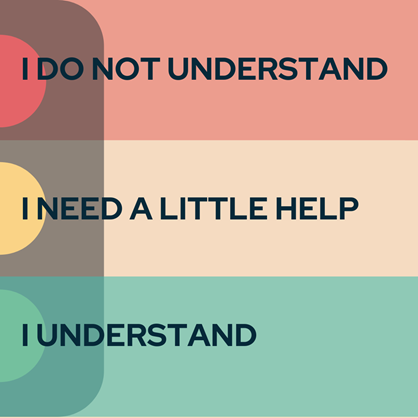Self Assessment with the Traffic Light System
A free professional blog to support English teachers

We often want to understand where our students are with their learning. A traffic light system can be a really useful tool to help your students measure and take responsibility for their learning in the classroom.
This week we will look at:
- How does the traffic light system work?
- How does it help students measure their learning?
- How to include the traffic light system in your classroom.
How does the traffic light system work?
Traffic lights themselves are relatively universal and even smaller children can understand what the colours mean, making the traffic light the perfect symbol to help your students make a self assessment of their learning. There are a number of ways a traffic light system can be introduced to the classroom but generally the aim is the same; to help the teacher and the student make an assessment of how much a student understands and to measure their learning. What does each colour of the traffic light system mean?
GREEN: I understand and do not require help
YELLOW: I need a little help but can make an attempt to get started
RED: I am having trouble or I do not understand the task.
How does the traffic light system help your students to measure their learning?
Traffic light systems have been shown to be an excellent tool to help students take responsibility for their own learning and help to identify their next step. One study, performed by Leyla Zeyno Tosunoglu showed that when the traffic light system was introduced to some students they tended to overestimate their abilities, whereas those who lacked confidence would often do the opposite, underestimating themselves. This enabled the teacher to intervene and give the students confidence or support where needed and as the study progressed it became clear that the students were beginning to think about their work and focus on their targets. It was shown that the traffic light system allowed the students to identify their strengths and areas for improvement and therefore positively impacted the students ability to learn.
How to include the traffic light system in your classroom
As mentioned previously there are a number of great ways to include the traffic light system in your classroom to help you and your students assess what they have learned. One example might be to provide your students with red, green and yellow stickers, at the end of each lesson have your students place a sticker in the corner of the worksheet or workbook indicating how they think they coped with the task. So green would indicate the student feels they coped well with the task and have a good understanding. Yellow would indicate they feel they coped okay but may have got some answers wrong and a red dot would indicate that the student struggled with the task and will need some extra support to feel comfortable.
Another way you may consider using the traffic light system in your classroom is during the lesson itself. Provide each student with a red, yellow and green card. Ask them to place the card on their desk as they are working to show how they are understanding the lesson. Green, as usual, indicates the student understands and is able to work without help, a yellow card placed on the desk means that the student is working but needs some help and a red card means that the student is stuck and cannot move forward without assistance. This enables you to move through the classroom helping students who may not always have the confidence to tell a teacher verbally that they do not understand.
For more tips on the traffic light system read our hand picked resources here: Traffic Light and Self-Assessment using Traffic Signals.
Or read more blog posts from The English Classroom here and be sure to sign up for our English teaching resources here. We will also send blog posts direct to your email.
Written by Rebecca Sparling